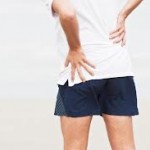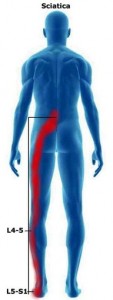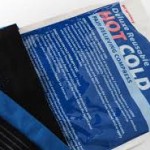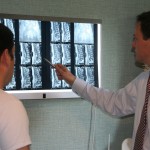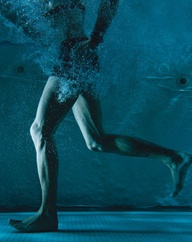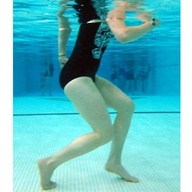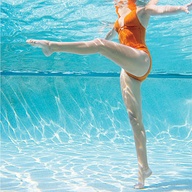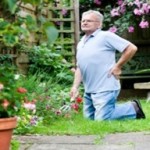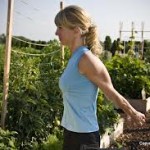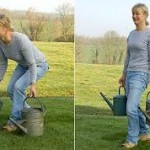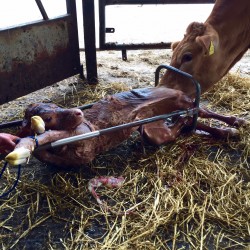Hip pain or low back pain; which is the culprit? by Olivia O’ Leary D.C BSc Hons
Hip pain or low back pain; which is the culprit?As a sufferer of low back or hip pain it can be sometimes difficult to pinpoint what structure is responsible for the pain you experience. Back problems can masquerade as hip problems with a lot of overlap noticeable. Most pain from hip and back problems has occurred as a result of ordinary strain and wear and tear on the body. Sometimes accidents such as falls have potential to contribute to the development of injury and pain.
When the Hip is the Usual Suspect
Surprisingly to patients, hip problems usually produce groin pain on the painful side. That’s because the actual joint of the hip is close to the groin rather than where most people think.
Groin pain is usually treated as a hip issue until proven otherwise through a full orthopaedic and neurological evaluation as well as X rays if deemed necessary. This type of evaluation process can conclusively determine the cause of the pain. Pain above the belt line is not deemed a hip issue but is typically related to the spine and pelvic joints instead.
One common cause of hip pain is osteoarthritis of the hip joint. You may have hip arthritis if:
- Pain is in your groin
- Discomfort comes and goes, becoming more frequent over time
- Pain worsens with standing, walking and activity, and is relieved by rest
- You feel stiff
- You walk with a limp
Other common causes of hip pain include Trochanteric Bursitis and Adductor Muscle (groin) strain.
When the Spine is the Likely Culprit
Many lower spine problems are caused by a herniated/prolapsed disc that presses on delicate nerves in the lower back. This can produce a pain known as sciatica, which can be felt in the hip. You may have a herniated disc if your pain:
- Is limited to your back, buttocks or hip
- Shoots down your leg
- Worsens with sitting or bending
- Improves when standing or walking
Unfortunately some people develop problems in both the hip and lower back. It’s not surprising, since malfunction of one area has a knock on negative compensatory affect on others. A diagnosis process will identify the main sources of pain and restriction and will ascertain how that disorder has the potential to cause aggravation to structures elsewhere.
FIRST STEPS FOR RELIEVING HIP PAIN
-
If your Hip Pain is Failing to Improve; it is likely you will need to seek help from a specialist. At Gorey Family Chiropractic our clinical team has extensive experience in the diagnosis, treatment and management of hip pain and our team can recommend the most appropriate plan of management whether that involves treatment, exercises or a combination of both for your disorder. Referral to can be arranged should your condition not be suitable for treatment.
- Lose Weight. Shedding extra pounds is critical in relieving certain types of hip pain. Losing weight often helps reduces symptoms of osteoarthritis and can delay further deterioration. It also increases your chances of a successful outcome if replacement surgery is one day warranted.
FIRST STEPS FOR RELIEVING BACK PAIN
- For Acute Back Pain: Initially rest is appropriate but research advocates avoiding prolonged bed rest of more than 24 to 48 hours. Instead try to remain mobile.
Ice applied to the injured area through a tea towel for 15-20 mins 3-4 times daily can assist with reducing inflammation. Meanwhile, try to stay active. Activity can and should be continued to avoid a loss of muscle tone essential for good spinal stability. Anti inflammatory medication can be used to help reduce inflammation and discomfort in the short term, but National Institute of Clinical Excellence in the U.K clinical guidelines recommend consultation with a practitioner such as chiropractor with trained expertise in the treatment of these disorders if the problem is persistent see below..
-
Schedule Chiropractic if needed after two weeks. If you’re still in pain after two weeks, a chiropractor can diagnose the underlying cause of the pain and recommend and administer appropriate treatment to relieve pain and improve mobility as well as showing you exercises that can help strengthen the muscles supporting your spine. Consideration and advice is given to patients concerning causation factors as well as prevention of recurrence.
- Lose Weight, take Exercise and quit Tobacco. Maintaining your ideal weight will take the pressure off your spine. Exercises have been shown to be an excellent way of maintaining spinal mobility as well as strengthening your spine which guards against injury. It’s important to avoid tobacco products too. Nicotine impedes microcirculation, so your spine will degenerate at a faster rate.
Gorey Family Chiropractic; Supporting your Recovery and Helping Maintain It
If the source of your pain is difficult to pinpoint, our specialist Clinical team are trained and hold extensive experience in the diagnosis, treatment and management of hip and back pain.
For your convenience all of our Gorey Family Chiropractic team are registered with VHI, Glo, Aviva and Laya Healthcare allowing clients claim reimbursement from a wide range of private healthcare Insurance providers. We also provide care under the GAA injury scheme.
Opening hours Mon 8-7, Tues 9-5, Wed 8-7, Thurs 9-5, Frid 8-7
Tel: 053 94 83338 or alternatively email info@chiropractor.ie
